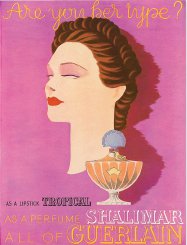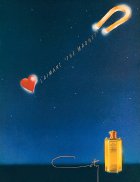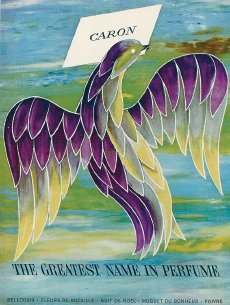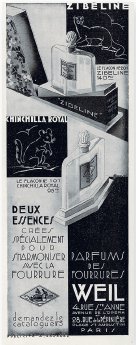Scent and Subversion (6 page)
Read Scent and Subversion Online
Authors: Barbara Herman

by Guerlain
(1925)

In this 1938 advertisement, Shalimar is this brunette’s type—or is it the other way around?
Perfumer:
Jacques Guerlain
Like Picasso’s portrait of Dora Maar, with three colors masterfully representing not only different planes on the subject’s face, but also her exquisite emotions, Shalimar juxtaposes the bracing zest of bergamot, the warmth of sensual vanilla, and the naughty raunch of civet. These should clash, just as those three colors in Maar’s portrait shouldn’t be able to create such an expressive face, and yet they combine to form something both striking and comforting.
Shalimar telegraphs opulence, comfort, and decadence, with a hint of the disreputable from the civet. What is it about civet? It lurks, it jumps out unexpectedly, it emits a low growl, adding mystery to every perfume
it’s in. If Shalimar were a gemstone, bergamot, vanilla, and civet would be the facets always hit by the light.
Lore has it that Jacques Guerlain was so taken with the newly available synthetic vanillin that he poured some into Jicky and their beautiful child was Shalimar. The “Guerlinade” found in Shalimar dries down to smell like skin—well, skin that is graced with orris and a hint of heavenly vanilla! As Chanel perfumer Ernest Beaux joked, there’s “crème anglaise” vanilla, and then there’s Guerlain vanilla. (
Guerlinade
is the name of the secret-formula accord of iris and tonka bean, give or take a few notes, which formed the base that constitutes Guerlain’s early, confectionary signature.) If Jicky is the
jolie laide
(“ugly beautiful”) of Guerlain scents, Shalimar is her easier-on-the-nose sister.
Top notes:
Bergamot, lemon, mandarin, rosewood
Heart notes:
Rose, jasmine, orris, vetiver, patchouli
Base notes:
Opopanax, vanilla, civet, Peru balsam, benzoin, coumarin (tonka bean), leather
by Chanel (1926)
Perfumer:
Ernest Beaux
Floral notes of jasmine and rose peek out of the thick scent of sandalwood that dominates Bois des Îles’ balsamic forest, with the the not-so-subtle spice of cinnamon from fallen tonka beans blanketing its forest floor, spreading a vanilla-ambery sweetness in its wake. The reformulated and denuded forest that is called Bois des Îles is a lovely light floral with almost no relation to its predecessor.
Notes:
Jasmine, damask rose, ylang-ylang, bitter almond, gingerbread, vanilla, tonka bean, sandalwood, vetiver
by Guerlain (1926)
Djedi was an ancient Egyptian soothsayer and magician famed for being able to make the dead come back to life. Quite a name for a perfume, but then again, Djedi isn’t just any perfume. Described as “the driest perfume of all time” (Roja Dove) and a “tremendous animalic vetiver” (Luca Turin), Djedi, like Chanel No. 19, creates a disquieting atmosphere as soon as you put it on. Vetiver is attended by a hint of clove and vanilla (not in the official list of notes), after which the comforting rank of civet darts around in the back like the actual animal. The rest of the Djedi rests on a chypre leather base.
The magic in Djedi is its ability to be both dramatic and quiet about it, like a secret pagan ritual going on under cover of darkness, with little fanfare. We don’t see Djedi performing his magic rituals, but we note the curling smoke, the burning incense, the
fragrant oils, the portent of something heavy and dark. We sense this as if we were intruders on an unseen and unseeable act of alchemy, something happening behind a curtain, just outside our purview.
If Djedi were on a color wheel, there would be nothing bright, but everything rich and deep: chartreuse, saffron, sable brown, inky black. I think of the forest in Guillermo del Toro’s film,
Pan’s Labyrinth,
filled with creatures that are beautiful, terrifying, and remote, in a fairy-tale land we can only fantasize about.
Notes from
Fragrantica.com:
Rose, vetiver, musk, oakmoss, leather, civet, patchouli
by Lanvin (1927)
Perfumers:
André Fraysse and Paul Vacher
Arpège is sensual beauty, slightly corrupted, at the end of a night of dining and dancing in stilettos, silk, and furs. The flowers are wilting on the table, sitting next to the fur coat that has absorbed the post-dinner cigarette smoke. This peach-led floral is enriched and fattened and rounded by ambrein, the primary molecule in ambergris, and its contrast of fresh peach with an erotic base make Arpège a classic vintage fragrance that nods both to the good girl and the bad.
Top notes:
Bergamot, neroli, aldehydes, peach
Heart notes:
Rose, jasmine, lily of the valley, ylang-ylang
Base notes:
Sandalwood, ambrein, vetiver, musk
by Coty (1927)

A 1943 advertisement for Coty’s L’Aimant
Perfumers:
Vincent Roubert and François Coty
Inspired by Chanel No. 5, L’Aimant (“Loving Her,” or “The Magnet”) is warm and sweet, like cut plums sautéed in butter and brandy and sprinkled with candied violets.
The powderiness in L’Aimant is saved from being too old-fashioned by the round, buttery, and sensual dark fruit and balsamic notes that underly the perfume, like bright oil colors on a dark velvet canvas. Jacques Guerlain’s wife loved L’Aimant so much, it is said that she even preferred it to her husband’s perfumes.
Notes not available
.
by Caron (1927)

Caron Perfumes, 1956
Perfumer:
Ernest Daltroff
I first approached Bellodgia before I could recognize the “color” of carnation, like a color-blind person looking at one of those visual tests and not being able to distinguish one colored dot in a sea of other colored dots. Now it seems so clear to me, having tried the more-intense carnation scents like Caron’s Poivre, Floris’s Malmaison, and the super-intense Roger & Gallet Blue Carnation. I no longer just smell a stew of cloying florals, and can appreciate, even if I could never wear, the lovely, and well-balanced Bellodgia.
With a bright bergamot/lemon opening, almost immediately warmed and rounded from nutmeg and vanilla, Bellodgia launches into a bouquet of sweet florals spiced with clove-faceted carnation. Musk, sandalwood, and vetiver give the base some carnal heft, but it’s the spicy floral heart that truly makes Bellodgia, the balance between sweetness with spice.
I like to think of perfumes going to the Ernest Daltroff finishing school, but instead of coming out ready to be debutantes and society ladies, they are ready to be ladies of the night or femme fatales. Bellodgia could have just been a well-behaved floral, but Daltroff’s addition of clovey-carnation spice becomes a mark, like an olfactory Scarlet Letter.
Top notes:
Bergamot, lemon, nutmeg, pimento berries
Heart notes:
Carnation, ylang-ylang, rose, jasmine, orris
Base notes:
Vetiver, vanilla, sandalwood, nitromusks
by Bourjois (1928)
Perfumer:
Ernest Beaux
With its luscious bergamot, apricot, and peach opening, a rich rose/jasmine heart greened and lightened by lily of the valley, and a spicy balsamic base, it’s easy to see why Evening in Paris was a hit, described as “The Most Popular Fragrance in the World.” Its opening soars with glamour and joy, like taking a ride down the Champs-Élysées for the first time and seeing the bright lights of Paris, illuminated water fountains, and the feeling of budding romance. In the drydown, an almost coconut sweetness bursts in. (This description is for vintage; the notes below are most likely for the 1991 reformulation.)
Top notes:
Bergamot, apricot and peach, green notes and violet
Heart notes:
Rose, jasmine, heliotrope, ylang-ylang, lily of the valley, and orris
Base notes:
Amber, musk, sandalwood, vanilla
by Weil
(1928)

This 1928 French advertisement showcases two Weil fragrances created specifically to harmonize with fur.
Seeing as we’re living in an age in which furs are frowned upon and perfume is being regulated out of existence, it’s hard to imagine anything more decadent or anachronistic than “parfum des fourrures” (fur perfumes), but Zibeline was in fact such a perfume. Named after the sable
Martes zibellina
, Zibeline was once advertised as “strictly an odor for furs,” made to keep furs from smelling musty without damaging them. (The Weil brothers were furriers before they became perfumers.) Spicy, sweet, and balsamic-powdery, Zibeline has a
pronounced heliotrope-like almond-cherry note from tonka that recalls Serge Lutens’s ode to Turkish Delight candy, Rahat Lakhoum, which shares Zibeline’s hawthorn, rose, and tonka notes. While it initially smells overwhelmingly of the cherry-almond heliotrope note at the beginning, its drydown brings out its multifaceted glory, with that accord radiating from the center of spice, powder, and balsamic warmth.
Notes from
1964 Dictionnaires de Parfums de France
:
Neroli, hawthorn, linden, rose, jasmine, ylang-ylang, incense, opopanax, oakmoss, vetiver, tonka bean, and civet
Top notes:
Aldehydes, bergamot, lemon, coriander, tarragon
Heart notes:
Rose, jasmine, lily of the valley, ylang-ylang, orris, gardenia
Base notes:
Vetiver, civet, sandal, amber, musk, honey, tonka
by Guerlain (1929)